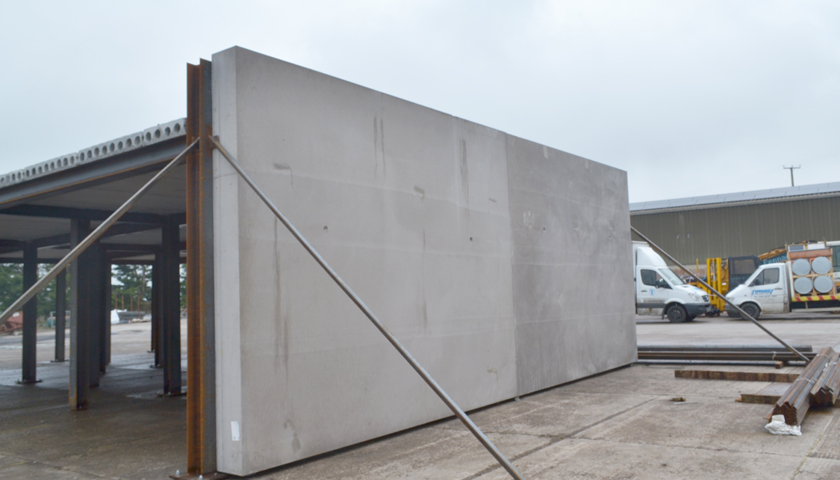BENEFITS:
• They provide a strong, durable, energy-efficient and fire resistant composite cladding system.
• All aspects of the production process are undertaken in an off-site factory environment, therefore achieving the highest possible quality finish.
• Construction is much faster with the ability to adopt a ‘just in time’ site delivery and a fully integrated structure and skin system where load-bearing wall panels provide both structural support and external finish, minimising
on-site labour cost.
• Prefabricated sandwich panels also eliminate the need for external scaffolding saving the main contractor costs and prelims.
DESIGN DETAILS
FP McCann’s insulated precast sandwich panels comprise of an outer layer of precast concrete, a central layer of PIR insulation and a structural internal layer of concrete with a power floated plain grey concrete finish. The external concrete layer is connected and supported by the internal concrete layer using proprietary ties. These ties have a low thermal conductivity which eliminates the potential of cold bridging.
The thickness of the insulation can be modified to accommodate the required U-value. The shape, thickness and size of the concrete can also be made to meet the requirements of the project. These panels can be supplied with various face finishes including the brick faced finish, natural stone faced finish, mould formers finish, acid etched finish and exposed aggregate finish.
The use of these insulated precast sandwich panels can help to drastically reduce installation periods and on-site safety hazards. The ability to fit various facades, windows and insulation during the manufacturing stage, reduces the need for numerous follow-on trades and eliminates the requirements for scaffolding.
DESTINCTIVE FEATURES
FP McCann’s insulated sandwich panels outer skin encasing the PIR insulation core consists of precast concrete. This differs from other panels which are manufactured using timber and aluminium.
The precast concrete does not burn and has a very low thermal conductivity in comparison to aluminium which has a low melting point (Approx. 660°C) and possesses a very high thermal conductivity (Approx. 140 W/m-K for some alloys at 0°C, EN 1999-1-2). Although, the thermal conductivity of timber is relatively low (Approx. 0.12 W/m-K at 20°C, EN 1995-1-2), it has been proven to be highly combustible.
Precast concrete, like other concrete types has an undefined melting point since it disintegrates into its base constituents around 1000°C. It also possesses a very low thermal conductivity (Approx. 2 W/m-K, upper limit at 20°C, EN 1992-1-2). The insulated precast sandwich panels provides significant fire resistance even with a combustible PIR insulation core. This is due to the outer precast concrete layers which are non-combustible having a low thermal conductivity and having the ability to withstand very high temperatures.
THE FIRE TESTS
As a part of a major international research initiative dealing with the influence of travelling fire in a large open compartment, three large fire tests were conducted by Ulster University sponsored by the Research Fund for Coal and Steel (RFCS) under the TRAFIR project. In this project FP McCann was a local sponsor with a research interest to investigate the behaviour of FP McCann’s insulated sandwich panels exposed to fire used as essential precast wall element in the compartment fire tests.
These panels were installed along one side of the test compartment and detailed instrumentation was applied to monitor the temperatures in the wall panels and in the test compartment. The instrumentation consisted of thermocouples, which were provided to record the temperatures in the inner and outer concrete layers as well as in the insulation layer of the precast sandwich panels.
The insulated precast sandwich panels were exposed to three fire scenarios and their behaviour was monitored. Timber was used as fuel due to its excellent combustibility. During the fire tests, temperatures in excess of 1000°C were recorded in the compartment. Also, special attention was paid to the fire resistance in terms of the fire exposure from the outside to the inside of the insulated precast wall panels. This was achieved by exposing the outer concrete layer with lower thickness to the elevated temperatures.
FIRE PERFORMANCE & FUTURE WORK
The insulated precast sandwich panels contained the fire while maintaining their structural integrity despite being exposed to multiple fire scenarios. Although explosive spalling on the exposed surface of concrete was observed during the tests, this spalling was relatively small and would have required limited remedial work. During the tests, the PIR insulation core of the sandwich panels remained encased within the layers of the precast concrete. The outer concrete layers, due to their low thermal conductivity, protected the PIR insulation core from direct
exposure to heat and flames. As a result, the PIR insulation core remained unharmed.
FP McCann has initiated an intensive study to realise the behaviour of insulated precast sandwich panels exposed to fire. Furthermore, a successful KTP project between FP McCann and FireSERT at Ulster University provided a scientifically fire rated precast solution with the aim to ensure the safety of occupants and properties where the insulated precast sandwich panels are used for building and construction purposes.
FP McCann aim to build a better, safer future and would encourage other manufacturers to follow a similar testing schedule incorporating real life scenario fire testing.
To find out more about Precast Sandwich Panels by FP McCann, click here


